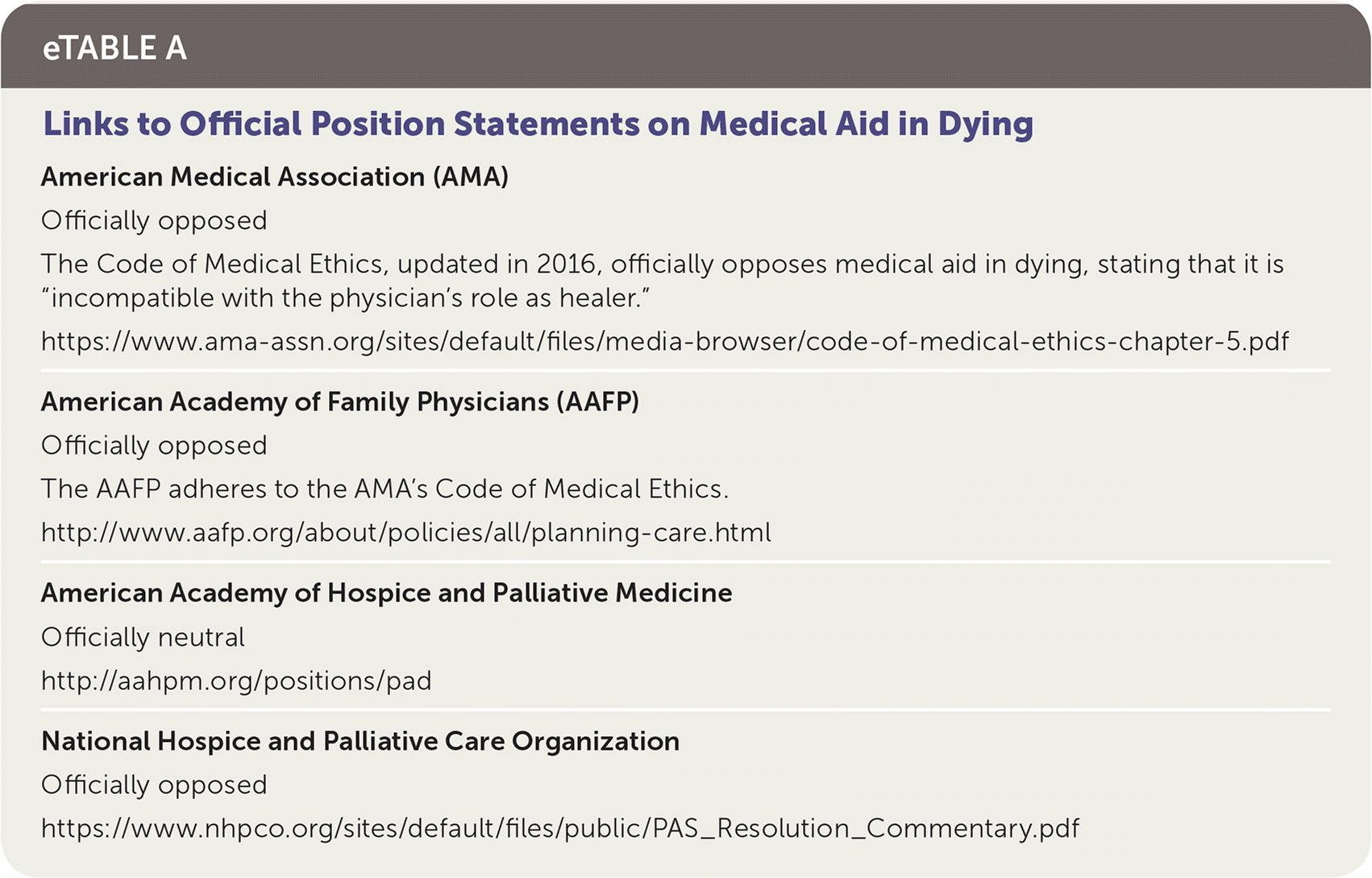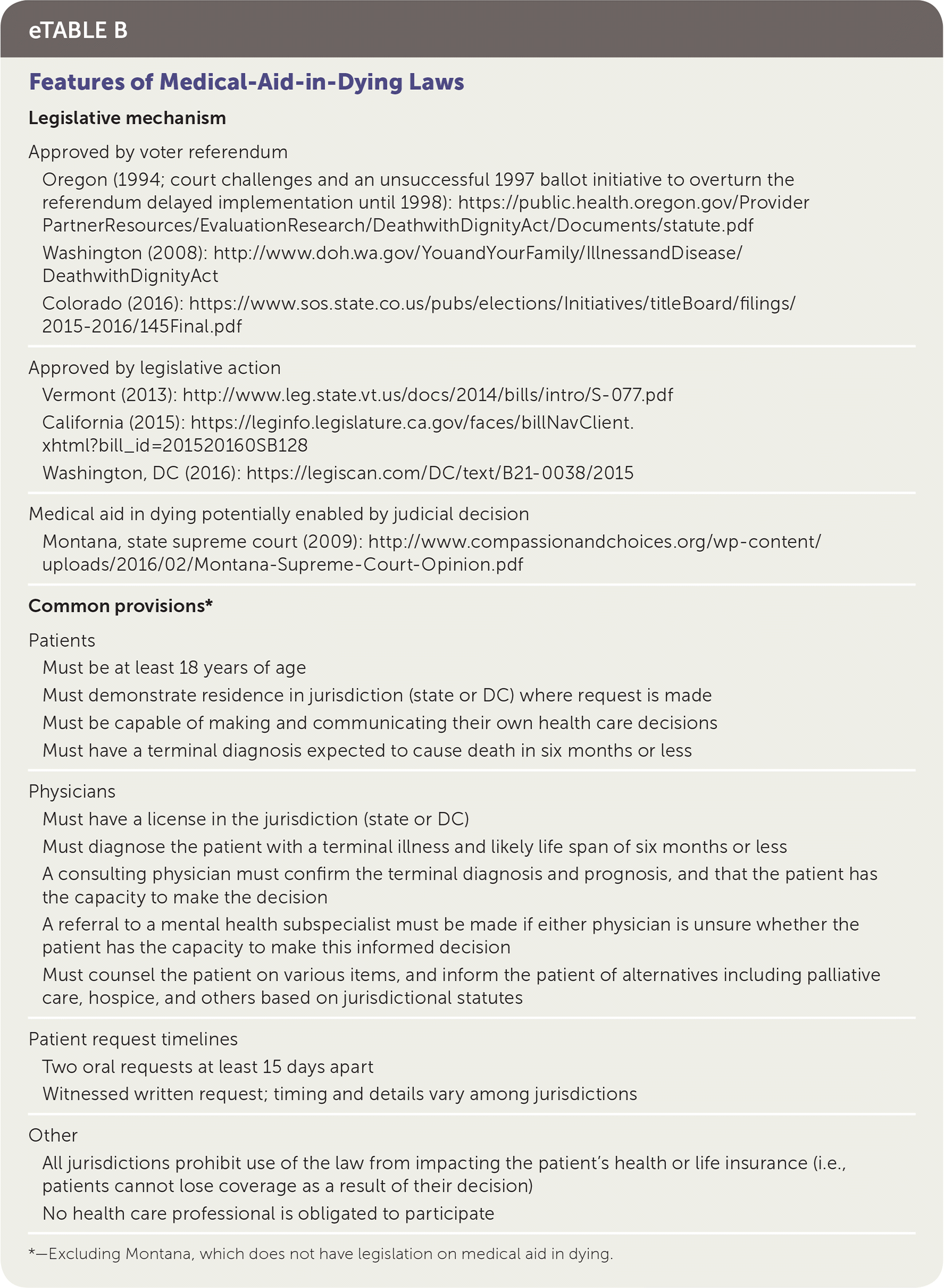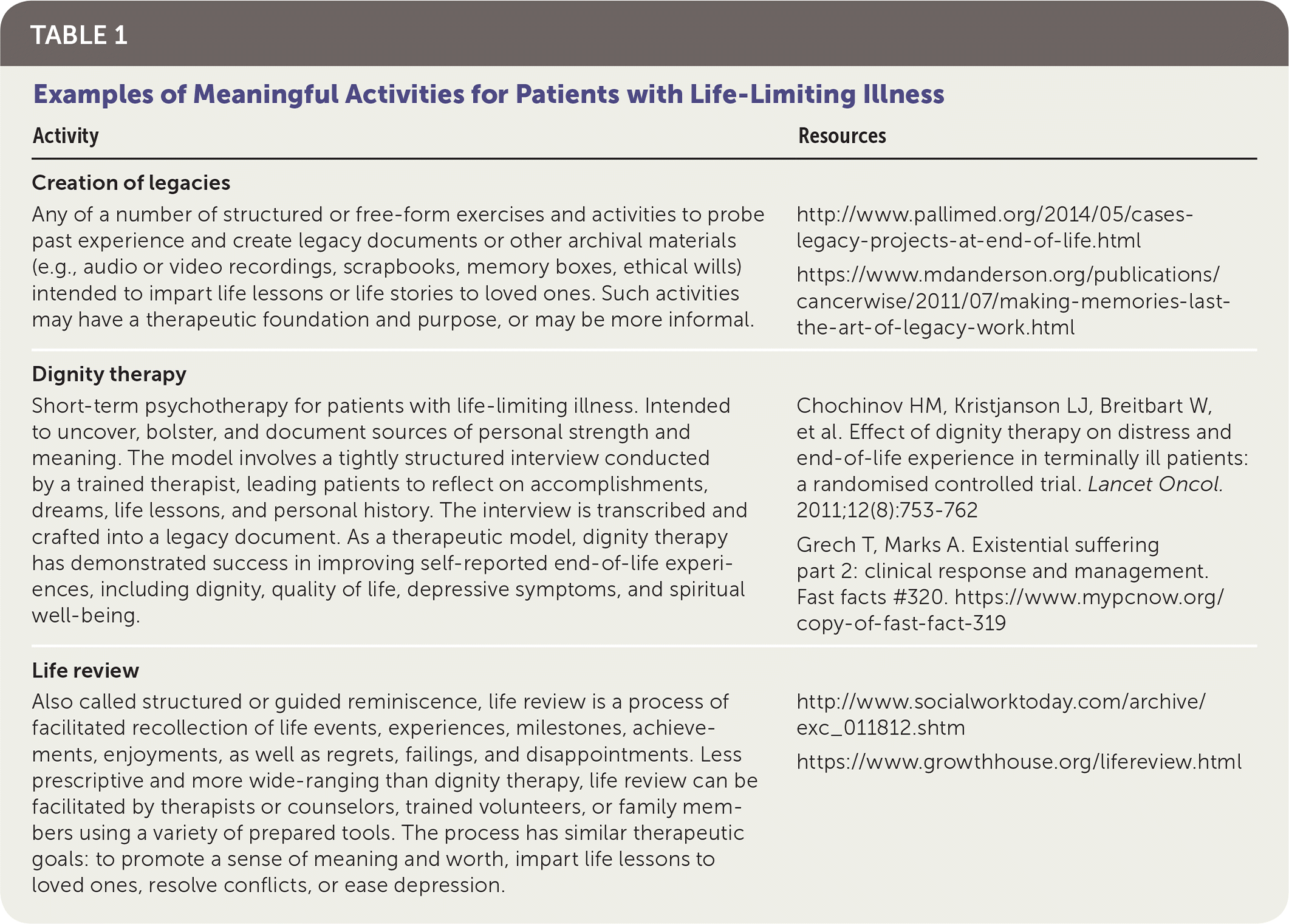
Am Fam Physician. 2018;97(5):339-343
Author disclosure: No relevant financial affiliations.
Case Scenario
A 63-year-old man presented to my office with stage D, New York Heart Association class III heart failure due to coronary artery disease. He also had type 2 diabetes mellitus and hypertension. He was recently hospitalized for an exacerbation of heart failure, his third hospitalization in eight months. At the visit, he commented on his fatigue and restricted lifestyle compared with how he had lived until the previous 18 months. Despite paying good attention to his medications and managing his other diseases appropriately, his quality of life remained poor. He said that he knew there are now several states that allow patients to end their lives with physician assistance. Although I do not work in one of these states, he asked whether I would be willing to help him, saying, “I just want this to be over.” I was not prepared for his question. What is the appropriate way to respond to requests like this?
Commentary
Requests for hastened death are not unusual from patients with life-limiting illness, and many primary care physicians encounter these requests over the course of their career. Medical aid in dying is the practice of a physician providing a competent, terminally ill patient—at the patient's request—with a prescription for a lethal dose of medication that the patient intends to use to end his or her own life. This practice differs from euthanasia, in which a clinician causes the death of a patient by administering a lethal dose of medication with the intent of ending the patient's suffering. Patients' suffering and subsequent requests for hastened death raise ethical, legal, and social concerns among individuals, organizations, and institutions across the United States. Links to official position statements from select organizations are provided in eTable A.

| American Medical Association (AMA) |
| Officially opposed |
| The Code of Medical Ethics, updated in 2016, officially opposes medical aid in dying, stating that it is “incompatible with the physician's role as healer.” |
| https://www.ama-assn.org/sites/default/files/media-browser/code-of-medical-ethics-chapter-5.pdf |
| American Academy of Family Physicians (AAFP) |
| Officially opposed |
| The AAFP adheres to the AMA's Code of Medical Ethics. |
| http://www.aafp.org/about/policies/all/planning-care.html |
| American Academy of Hospice and Palliative Medicine |
| Officially neutral |
| http://aahpm.org/positions/pad |
| National Hospice and Palliative Care Organization |
| Officially opposed |
| https://www.nhpco.org/sites/default/files/public/PAS_Resolution_Commentary.pdf |
Although euthanasia is illegal in the United States, medical aid in dying is legal in five states and Washington, DC, and similar statutes have been proposed in approximately two dozen other states (eTable B). However, this commentary does not review the legal or ethical issues involved in responding to such requests, nor do we advocate for any particular decision an individual physician might make. Instead, we outline a compassionate, stepwise response that honors patients' and physicians' experiences and beliefs, and moves toward improving patients' quality of life. Other examples of stepwise approaches are available in the literature.1,2

| Legislative mechanism | |
| Approved by voter referendum | |
| Oregon (1994; court challenges and an unsuccessful 1997 ballot initiative to overturn the referendum delayed implementation until 1998): https://public.health.oregon.gov/ProviderPartnerResources/EvaluationResearch/DeathwithDignityAct/Documents/statute.pdf | |
| Washington (2008): http://www.doh.wa.gov/YouandYourFamily/IllnessandDisease/DeathwithDignityAct | |
| Colorado (2016): https://www.sos.state.co.us/pubs/elections/Initiatives/titleBoard/filings/2015-2016/145Final.pdf | |
| Approved by legislative action | |
| Vermont (2013): http://www.leg.state.vt.us/docs/2014/bills/intro/S-077.pdf | |
| California (2015): https://leginfo.legislature.ca.gov/faces/billNavClient.xhtml?bill_id=201520160SB128 | |
| Washington, DC (2016): https://legiscan.com/DC/text/B21-0038/2015 | |
| Medical aid in dying potentially enabled by judicial decision | |
| Montana, state supreme court (2009): http://www.compassionandchoices.org/wp-content/uploads/2016/02/Montana-Supreme-Court-Opinion.pdf | |
| Common provisions* | |
| Patients | |
| Must be at least 18 years of age | |
| Must demonstrate residence in jurisdiction (state or DC) where request is made | |
| Must be capable of making and communicating their own health care decisions | |
| Must have a terminal diagnosis expected to cause death in six months or less | |
| Physicians | |
| Must have a license in the jurisdiction (state or DC) | |
| Must diagnose the patient with a terminal illness and likely life span of six months or less | |
| A consulting physician must confirm the terminal diagnosis and prognosis, and that the patient has the capacity to make the decision | |
| A referral to a mental health subspecialist must be made if either physician is unsure whether the patient has the capacity to make this informed decision | |
| Must counsel the patient on various items, and inform the patient of alternatives including palliative care, hospice, and others based on jurisdictional statutes | |
| Patient request timelines | |
| Two oral requests at least 15 days apart | |
| Witnessed written request; timing and details vary among jurisdictions | |
| Other | |
| All jurisdictions prohibit use of the law from impacting the patient's health or life insurance (i.e., patients cannot lose coverage as a result of their decision) | |
| No health care professional is obligated to participate | |
Step 1. Clarify the request. The patient in this scenario has made an overt request for assistance in dying, couched in the context of what is allowed in other states. Often, requests for help are more nuanced. Patients may make statements such as, “I can't go on suffering like this. Isn't there something you can do to help me end this?” Even when patients are more direct, as in this case, there are uncertainties. We may be unsure what exactly the patient is asking for: medical aid in dying, euthanasia, a referral to a colleague in a state where medical aid in dying is legal, or exploration of what measures we are willing to take in the future. Many times, the request is actually about the patient's desire to improve his or her quality of life. When physicians pay attention to the patient's pain, the desire for hastened death may abate. Examples of clarifying questions may include the following: “I hear that your heart failure is impacting the way you want to live. Help me understand what is going on and how you hope I can help”; “Are you asking if I can help hasten your death, or if I can help improve your life?”; or “What are your goals and concerns if medical aid in dying is not available to you?”
Step 2. Understand the motivation behind the request. These requests may arise at diagnosis, with increasing symptoms, or with decreased support. Advancing illness is known to cause patient suffering in various dimensions (e.g., physical, emotional, social, spiritual).3 Often, patients are motivated by concerns such as loss of autonomy or control, hopelessness, or feeling like a burden to others.4 Patients may be depressed, which impairs quality of life and exacerbates hopelessness, even if depression does not confer decisional incapacity. Exploring how the patient experiences his or her illness can be useful to the patient and physician. Asking questions such as, “What is most important to you right now?” or “What are you most concerned about in the future?” may clarify general concerns. Physicians may further ask, “Before we get into details, please help me understand what has led you to ask this question”; “When did things change for you?”; or “What do you think will be better if you pursue this?” Depression can be difficult to assess in patients with advanced illness because of the overlap of symptoms.5 One effective depression screening question is, “Are you depressed most of the time?”
Step 3. Affirm your commitment to care for the patient. The patient in this scenario is clearly distressed, and reaching out for help makes him even more vulnerable. Patients' experience of disease progression can increase their isolation and feeling devalued as a person. Contemplating a hastened death can compound patients' sense of loneliness. The physician should make a statement that he or she will work with the patient to address current and future concerns. Let the patient know that you want to continue to be his or her physician. Engaging the patient in identifying solutions can be useful. For example, “No matter where you end up in this, I want to work with you to make your life the best it can be. What ideas do you have about things we can do that might make a difference quickly? We can work on long-term issues, too.”
Step 4. Begin to address the problems or concerns. Physicians can help patients by doing the following: developing plans to improve physical and psychological or existential symptoms; negotiating reassessments of those symptoms, with expected time frames for reevaluation; assessing whether the patient is considering taking his or her own life if medical aid in dying is not available; addressing possible fears, such as abandonment, dependency, becoming a burden, or worsening pain; suggesting meaningful activities such as creation of legacies, dignity therapy, or life review (Table 1); and bolstering the patient's personal strengths. Some clinicians and practices will be able to manage this work within the office setting, but often community resources are useful. Social workers, care managers, community palliative services, disease advocacy organizations, the local Area Agency on Aging, and other community resources can be helpful. Palliative care consultation leads to improved quality of life and other outcomes for patients with serious illness.6–11 Eligible patients who receive hospice care can benefit from the multidisciplinary team focus on relief of suffering.

| Activity | Resources |
|---|---|
| Creation of legacies | |
| Any of a number of structured or free-form exercises and activities to probe past experience and create legacy documents or other archival materials (e.g., audio or video recordings, scrapbooks, memory boxes, ethical wills) intended to impart life lessons or life stories to loved ones. Such activities may have a therapeutic foundation and purpose, or may be more informal. | http://www.pallimed.org/2014/05/cases-legacy-projects-at-end-of-life.html |
| https://www.mdanderson.org/publications/cancerwise/2011/07/making-memories-last-the-art-of-legacy-work.html | |
| Dignity therapy | |
| Short-term psychotherapy for patients with life-limiting illness. Intended to uncover, bolster, and document sources of personal strength and meaning. The model involves a tightly structured interview conducted by a trained therapist, leading patients to reflect on accomplishments, dreams, life lessons, and personal history. The interview is transcribed and crafted into a legacy document. As a therapeutic model, dignity therapy has demonstrated success in improving self-reported end-of-life experiences, including dignity, quality of life, depressive symptoms, and spiritual well-being. | Chochinov HM, Kristjanson LJ, Breitbart W, et al. Effect of dignity therapy on distress and end-of-life experience in terminally ill patients: a randomised controlled trial. Lancet Oncol. 2011;12(8):753–762 |
| Grech T, Marks A. Existential suffering part 2: clinical response and management. Fast facts #320. https://www.mypcnow.org/copy-of-fast-fact-319 | |
| Life review | |
| Also called structured or guided reminiscence, life review is a process of facilitated recollection of life events, experiences, milestones, achievements, enjoyments, as well as regrets, failings, and disappointments. Less prescriptive and more wide-ranging than dignity therapy, life review can be facilitated by therapists or counselors, trained volunteers, or family members using a variety of prepared tools. The process has similar therapeutic goals: to promote a sense of meaning and worth, impart life lessons to loved ones, resolve conflicts, or ease depression. | http://www.socialworktoday.com/archive/exc_011812.shtml |
| https://www.growthhouse.org/lifereview.html | |
Step 5. Discuss the legal and ethical alternatives. Physicians who live in a state where medical aid in dying is legal should understand the eligibility and procedural requirements for patient participation (eTable B). Physicians are not legally required to prescribe or participate.12 Additional legal options available to patients in all states should be discussed. These include discontinuing burdensome therapies, such as oral fluids and nutrition. Some conditions may be intractable and amenable only to palliative sedation, which is typically administered in the last days or weeks of life.
Patients who make requests for medical aid in dying have significant suffering, or fear of suffering, and working with them is challenging but also potentially rewarding. When patients ask us to help shorten their lives, we are required to sort through our own emotional, spiritual, and professional responses.13 Sharing our challenges with trusted colleagues, therapists, or other support persons is an important part of physician self-care, allowing us to continue our focus on patient needs.
